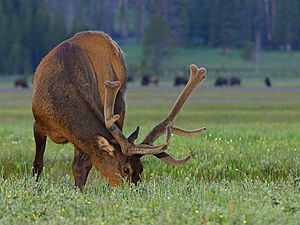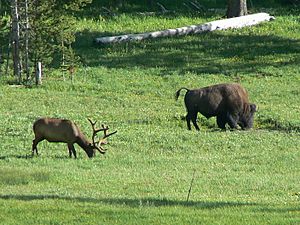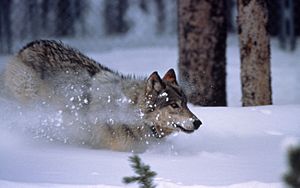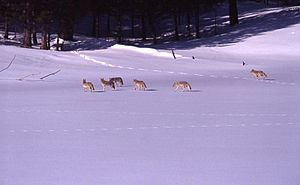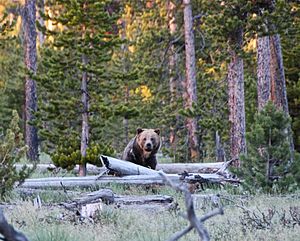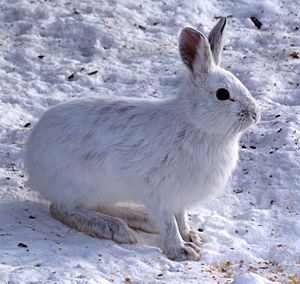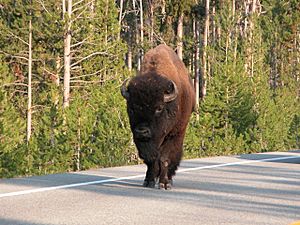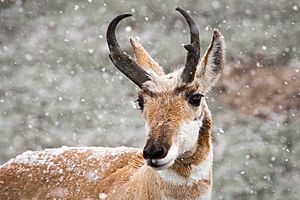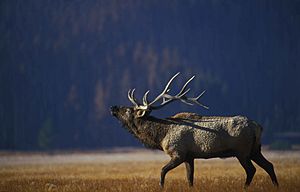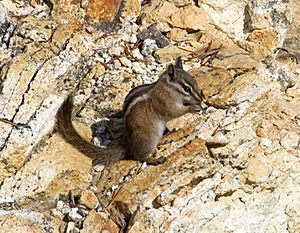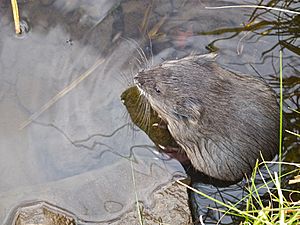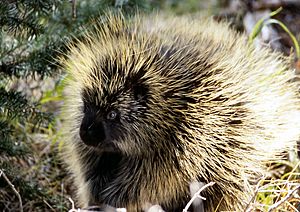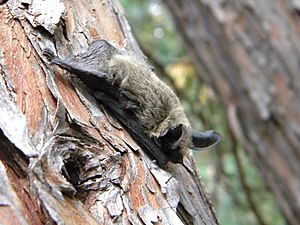List of mammals of Yellowstone National Park facts for kids
Yellowstone National Park is a huge protected area in the Rocky Mountains! It covers about 2.2 million acres across Wyoming, Montana, and Idaho. This amazing park is home to at least 67 different kinds of mammals. From tiny shrews to giant bison, Yellowstone is a wildlife wonderland.
This article will introduce you to some of the incredible mammals living in Yellowstone. You'll learn about different animal families, their science names, where they usually live, and how common they are in the park.
Contents
Meet the Mammals of Yellowstone
Wild Dogs and Wolves
This group includes animals from the dog family, known as Canidae. They are all part of the Carnivora order, meaning they are meat-eaters.
- Coyote (Canis latrans): You can often spot coyotes in valleys, grasslands, and forests. They are very common.
- Northwestern Wolf (Canis lupus occidentalis): Wolves also live in valleys, grasslands, and forests. They are common in the park.
- Wasatch Mountain Fox (Vulpes vulpes macroura): These foxes prefer meadows and forests. They are common to see.
Bears of Yellowstone
The bear family, Ursidae, includes two large and powerful species in Yellowstone. They are also part of the Carnivora order.
- Grizzly Bear (Ursus arctos horribilis): Grizzlies can be found in grasslands, forests, and high alpine areas. They are common in the park.
- American Black Bear (Ursus americanus): Black bears mostly live in the forests of Yellowstone. They are also common.
Raccoons
The raccoon family, Procyonidae, has one member in Yellowstone.
- Common Raccoon (Procyon lotor): Raccoons usually live near rivers and cottonwood trees. They are rare to spot in the park.
Wild Cats
The Felidae family includes some of the park's most elusive hunters.
- Cougar (Puma concolor): Also known as mountain lions, cougars live in forests and rocky areas. They are uncommon to see.
- Canada Lynx (Lynx canadensis): These beautiful cats prefer coniferous forests. They are quite rare.
- Bobcat (Lynx rufus): Bobcats are found in coniferous forests and rocky spots. They are common.
Weasels and Their Relatives
The Mustelidae family is a diverse group of carnivores, often known for being quick and clever.
- Wolverine (Gulo gulo): Wolverines live in high alpine areas and coniferous forests. They are rare.
- North American River Otter (Lontra canadensis): Otters love rivers and are common to see playing in the water.
- Pacific Marten (Martes caurina): Martens live in coniferous forests and are common.
- American Ermine or Short-tailed Weasel (Mustela richardsonii): These small weasels live in willows and spruce forests. They are common.
- Long-tailed Weasel (Neogale frenata): Found in forests, meadows, and wetlands, these weasels are common.
- American Mink (Neogale vison): Minks live near streams and rivers. They are uncommon.
- Fisher (Pekania pennanti): Fishers prefer forests and are rare.
- American Badger (Taxidea taxus): Badgers live in grasslands and sagebrush areas. They are common.
Skunks
The Mephitidae family includes the well-known skunk.
- Striped Skunk (Mephitis mephitis): These skunks live in forests near rivers. They are rare in Yellowstone.
Rabbits and Hares
The Leporidae family includes rabbits and hares, known for their long ears and powerful hind legs.
- Mountain Cottontail (Sylvilagus nuttallii): These rabbits live in shrublands and are common.
- Desert Cottontail (Sylvilagus audubonii): Also found in shrublands, these cottontails are common.
- Snowshoe Hare (Lepus americanus): Snowshoe hares live in coniferous forests and willow areas. They are common.
- White-tailed Jackrabbit (Lepus townsendii): These hares prefer sagebrush and grasslands. They are common.
Pikas
The Ochotonidae family has one small, cute member in Yellowstone.
- American Pika (Ochotona princeps): Pikas live in high alpine areas and rocky spots. They are common.
Bison, Bighorn Sheep, and Mountain Goats
The Bovidae family includes large, hoofed animals.
- Plains Bison (Bison bison bison): Yellowstone is famous for its bison herds, which live in grasslands, sagebrush, and shrubland. They are abundant!
- Rocky Mountain Bighorn Sheep (Ovis canadensis canadensis): These sheep live on cliffs, rocky areas, and alpine tundra. They are uncommon.
- Mountain Goat (Oreamnos americanus): Mountain goats also live on cliffs and in alpine tundra. They are uncommon and not native to the park.
Pronghorn
The Antilocapridae family has only one living species, the pronghorn.
- Pronghorn (Antilocapra americana): Pronghorns are found in sagebrush and grasslands. They are common.
Elk, Moose, and Deer
The Cervidae family includes deer, elk, and moose, all known for their antlers.
- Northwestern White-tailed Deer (Odocoileus virginianus ochrourus): These deer live in grasslands and forests. They are uncommon.
- Rocky Mountain Mule Deer (Odocoileus hemionus hemionus): Mule deer are common in grasslands, shrubland, and forests.
- Rocky Mountain Elk (Cervus canadensis nelsoni): Elk are the most abundant large mammal in Yellowstone, found in grasslands, shrubland, forests, and alpine tundra.
- Shiras Moose (Alces alces shirasi): Moose live in grasslands, forests, and near rivers and lakes. They are uncommon.
Tiny Shrews
The Soricidae family includes very small, mouse-like mammals called shrews.
- Dusky Shrew (Sorex monticolus): These shrews live in meadows and forests. They are common.
- Masked Shrew (Sorex cinereous): Also found in meadows and forests, masked shrews are common.
- American Water Shrew (Sorex palustris): Water shrews live in meadows and near rivers. They are common.
- Preble's Shrew (Sorex preblei): These shrews are rare, if present, in meadows and forests.
- Dwarf Shrew (Sorex nanus): Dwarf shrews are common in meadows and forests.
Beavers
The Castoridae family has one very busy member.
- American Beaver (Castor canadensis): Beavers live near rivers and streams. They are fairly common and their numbers are increasing.
Squirrels and Chipmunks
The Sciuridae family includes many familiar rodents like squirrels, chipmunks, and marmots.
- Least Chipmunk (Neotamias minimus): These tiny chipmunks are common in meadows and forests.
- Uinta Chipmunk (Neotamias umbrinus): Uinta chipmunks are common in meadows and forests.
- Yellow-pine Chipmunk (Neotamias amoenus): These chipmunks are common in meadows and forests.
- American Red Squirrel (Tamiasciurus hudsonicus): Red squirrels are common in coniferous forests.
- Northern Flying Squirrel (Glaucomys sabrinus): Flying squirrels live in forests and are seen occasionally.
- Yellow-bellied Marmot (Marmota flaventris): Marmots are common in forests, meadows, and rocky areas.
- Uinta Ground Squirrel (Urocitellus armatus): These ground squirrels are common in meadows and sagebrush.
- Golden-mantled Ground Squirrel (Callospermophilus lateralis): Common in meadows, forests, rocky areas, and alpine tundra.
Voles and Woodrats
The Cricetidae family includes many small rodents.
- Common Muskrat (Ondatra zibethicus): Muskrats live near rivers and are seen occasionally.
- Western Heather Vole (Phenacomys intermedius): These voles live in sagebrush, grasslands, and forests. They are occasional.
- Water Vole (Microtus richardsoni): Water voles live near rivers and are seen occasionally.
- Long-tailed Vole (Microtus longicaudus): These voles are common in meadows.
- Southern Red-backed Vole (Myodes gapperi): Red-backed voles are common in coniferous forests.
- Meadow Vole (Microtus pennsylvanicus): Meadow voles are common in meadows.
- Montane Vole (Microtus montanus): These voles are common in meadows, sagebrush, and near rivers.
- Bushy-tailed Woodrat (Neotoma cinerea): Woodrats are common in rocky areas.
Mice
The Cricetidae family also includes this common mouse.
- Deer Mouse (Peromyscus maniculatus): Deer mice are common in grasslands.
Jumping Mice
The Dipodidae family has one type of jumping mouse in Yellowstone.
- Western Jumping Mouse (Zapus princeps): These mice live near rivers and are seen occasionally.
Porcupines
The Erethizontidae family has one spiky member.
- North American Porcupine (Erethizon dorsatum): Porcupines are common in forests, sagebrush, and near rivers.
Bats
The Vespertilionidae family includes many types of bats that fly at night.
- Little Brown Bat (Myotis lucifugus): These bats roost in caves, trees, and buildings. They are common.
- Big Brown Bat (Eptesicus fuscus): Big brown bats roost in sheltered areas and are common.
- Long-eared Myotis (Myotis evotis): These bats roost on cliffs and in buildings. They are uncommon.
- Long-legged Myotis (Myotis volans): Roosting in cliffs, tree cavities, and buildings, these bats are common.
- Townsend's Big-eared Bat (Coryhinus townsendii): These bats roost in caves and are uncommon.
- Fringe-tailed Bat (Myotis thysanodes): Fringe-tailed bats roost on cliffs and in snags (dead trees). They are uncommon.
- Hoary Bat (Lasiurus cinereus): Hoary bats roost in trees and are uncommon.
- Silver-haired Bat (Lasionycteris noctivagans): These bats roost in trees and snags. They are common.
- Spotted Bat (Euderma maculatum): Spotted bats roost on cliffs and trees. They are uncommon.
- Pallid Bat (Antrozous pallidus): These bats roost on cliffs, in caves, and buildings. They are uncommon.
- California Myotis (Myotis californicus): These bats roost in trees, rock crevices, and buildings.
- Western Small-footed Myotis (Myotis ciliolabrum): Small-footed myotis bats roost in caves and rocky areas. They are rare.
- Yuma Myotis (Myotis yumanensis): Yuma myotis bats roost in caves, buildings, and trees. They are rare.
See also


